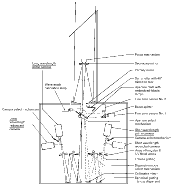|
|||||||||||||||||||
|
|
|||||||||||||||||||
|
|
Scientific Instrument
The IUE scientific instrument consists of a telescope, acquisition camera, two ultraviolet spectrographs, and four cameras.
Telescope: The telescope is a 45-cm aperture, f/15 telescope of Ritchey-Chretien design. The primary mirror is made of beryllium. Thermal heaters mounted on the back of the mirror and on the camera deck are used for focus control.
Acquisition camera: The Fine Error Sensor (FES) is an image dissector device sensitive to a broad range of visual wavelengths. It has a 16 arcmin field of view and effective image resolution of about 8 arcsec. The device is used in camera mode to obtain a visual star field image for target identification and acquisition. It is then used in tracking mode for offset guiding, providing a pointing stability of about 1/2 arcsec.
Apertures: Each spectrograph may be used with either of two apertures. The large aperture is a slot (approximately 10 by 20 arcsec) and the small aperture is a circle about 3 arcsec in diameter. The apertures are known as LWLA (long-wavelength large aperture), LWSA (long-wavelength small aperture), SWLA (short-wavelength large aperture), and SWSA (short-wavelength small aperture). The image quality of the IUE telescope's optics yields a roughly 3 arcsec image, so observations using the small aperture result in some light loss. The large apertures are used most frequently since they give photometric reliability with little or no loss of resolution.
Spectrographs: The long-wavelength spectrograph operates in a wavelength range of 1850 to 3300 Å. The short-wavelength spectrograph operates in a wavelength range of 1150 to 2000 Å.
Dispersion modes: Each spectrograph has two dispersion modes. High resolution employs an echelle grating and cross-disperser, giving roughly 0.2 Å resolution). Low resolution employs the cross-disperser grating alone, and yields approximately 6 Å resolution.
Cameras: There are four cameras, two for each spectrograph. One is designated prime and the other backup. In the long-wavelength range, both the prime (LWP) and redundant (LWR) cameras were used during the mission. With the short-wavelength spectrograph, only the prime camera (SWP) was fully functional. The redundant camera (SWR) was used to obtain a handful of images early in the mission. Each camera consists of an SEC Vidicon with and ultraviolet converter. Each exposure is obtained by integrating over the requested exposure time, then performing a destructive readout of the camera target. The signal is digitized and transmitted to the ground via the spacecraft telemetry stream.
Data format: Each IUE image consists of a 768 by 768 pixel array of 8-bit values (0 to 255). The raw data are archived with a header recording Telescope Operator comments, automatic activity log, and spacecraft engineering data.
|
|
|




 Follow Us
Follow Us
